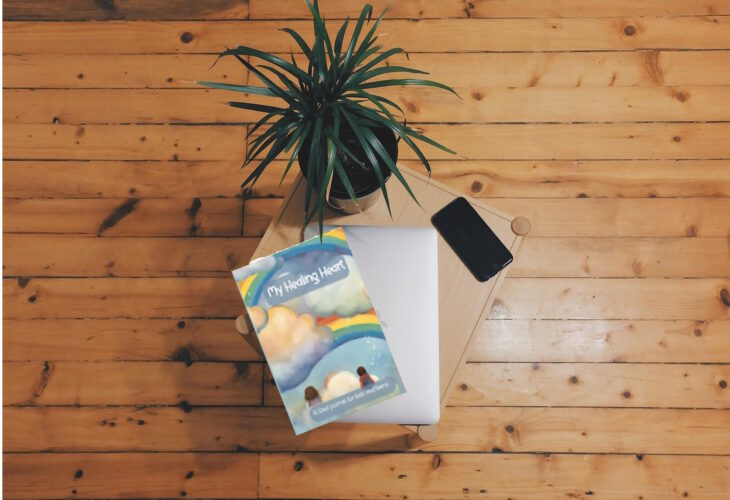In her work as a funeral officiant, Vanessa Bower works with families who are trying to deal with the grieving process. So she was very happy when she came across a grief journal created for South African children.
The book is called My Healing Heart: A Grief Journal for kids and teens aged 8 – 13 years. Vanessa met with author Louise Golding to find out more about the journal.

About the Inspiration and Creation
What inspired you to create a grief journal specifically for children and young people?
My husband passed away in July 2024 so as my family was going through this significant loss I wanted to create a tool that my children could use to process their emotions. My oldest daughter, Chris and I worked together to create something that we felt was useful. She is a fabulous artist and has created a wonderfully soothing aesthetic that is very welcoming and gentle, perfect for a younger user.
Did your own personal experiences with grief influence this project?
Absolutely. As I was experienced grief myself, I knew how hard it was to navigate those emotions—even as an adult. For children, who often lack the words or tools to process loss, it felt even more important to create something gentle and accessible. I wanted my kids (and others) to have a safe space where they could explore their feelings without fear or pressure.
Why did you choose the age range of 8–13 years?
My youngest child falls in this age range and in this range kids processes grief in the same framework. Research shows that Ages 8–10 start to grasp the permanence of death but may still struggle with abstract concepts (e.g., “Why did this happen?”). Magical thinking ( like “If I behave better, they’ll come back”) can linger.
Ages 11–13: More logical understanding of death, but may ruminate on “unfairness” or existential questions (“Will this happen to me too?”).
About the Journal Itself
Can you tell us a little bit about how the journal is structured?
The journal is set up for the user to free flow their feelings and have a place to express what they are going through. There are journal prompts and starting points but it is for the individual to have a place to process creatively.
What kinds of activities, prompts, or exercises can children expect to find inside?
The book includes a range of cut-and-paste activities. There are pages for journal entries or thought dumping. We’ve included encouraging sayings for when you need a bit of input and some movement exercises, too.
There’s space for gratitude journaling – even in grief , it’s good to find thanks.
There are little bits of education too. We’ve included information about stress and grief and self care. It’s helpful to know what to expect as normal.
There is space for memories of your loved one. Sometimes using your creativity can be really soothing.

How does the journal encourage self-expression in children who may struggle to talk openly about their feelings?
Having a safe space to express what can be hard to articulate can be the first step in being able to speak about something. My hope is that this book can be a starting place for someone who is finding it hard to reach out.
In your view, what makes journaling a particularly helpful tool for processing grief?
The creative side of our brain is where problem-solving happens. By exercising our brain and encouraging creativity, we can often see a new way through a problem that may seem overwhelming to start with. Grief often feels confusing, especially for young people who may not yet have the language to describe what they’re experiencing. Writing or drawing allows them to release those feelings in a way that feels private, personal, and safe.
Supporting Families and Children
How can parents, guardians, or teachers support children as they use the journal?
The journal can be a great symbol of support to a child who is grieving. The most important way to support a child using the grief journal is to create a safe, open, and non-judgmental space for them to express their feelings in their own time and way. Every child grieves differently, and the journal is meant to gently guide them through that process — not rush it or “fix” their feelings
What role do you think tools like this can play alongside other forms of grief support, such as counselling or support groups?
I think the two work beautifully together. Having a face-to-face conversation with someone is invaluable. It’s great to know that you’re not alone. Having a private space to process what you’re feeling often leads to the beginnings of deep discussions. It helps make sense of grief in their own words and at their own pace — it’s not a replacement, but a bridge that deepens the healing process.
Have you received any feedback from children or families who have used the journal, and if so, what has stood out to you?
I haven’t received direct feedback from children or families yet — the journal is still quite new — but I’ve been really touched by how warmly parents, teachers, and counsellors have responded to it. Many have said it feels like something that’s been missing — a gentle, approachable way to help children open up about loss. I’m truly looking forward to hearing how families use it in their own way and how it supports their healing journeys.
Broader Impact of the Grief Journal
What do you hope children will gain from using this journal?
My hope is that this journal be a comfort in a painful chapter of the user’s life. Unfortunately, grief is inevitable, but navigating it so young can be devastating. I hope to be one of the ways that children can find support.
How do you think society could improve the way we support grieving children and teenagers?
Too often, adults try to protect young people by avoiding the topic, but that can leave them feeling isolated or unsure of what’s “okay” to feel.
If we could normalize conversations about loss — at home, in schools, and in communities — we’d permit children to grieve in healthy ways. They need to know it’s okay to be sad, angry, or confused, and that grief doesn’t have a timeline.
We can also do more to give them age-appropriate tools and safe spaces — whether that’s through journals, art, play, or peer support — so they can express what’s inside without fear of getting it “wrong.” Ultimately, it’s about showing them that their feelings are valid and that they don’t have to carry grief alone.
What would you say to adults who are unsure how to start conversations with children about death and grief?
Keep it simple. Try and let them lead the conversation. Give them space to let you know where they are. They are probably processing things differently than you and that’s okay. You don’t need to have all the right words; what matters most is your presence and openness. Children often take their cues from the adults around them — if we can speak about death gently and truthfully, it shows them it’s safe to ask questions and share their feelings.
Personal and Practical
What was the most challenging part of creating this resource?
The style was very important to me. I wanted something that would appeal to the age group. Luckily, I was collaborating with a very talented artist 😉
What was the most rewarding part?
It’s always wonderful to see a project come together, but this one feels especially meaningful. One of my core values is nurture, and creating this journal was an extension of that — a way to offer comfort and gentle guidance to children when words are hard to find. Knowing that something I’ve made might help a child feel a little less alone is really rewarding. It’s one more small piece of nurture I’ve put out into the world, and that means a lot to me.
Do you have any future plans to create other grief-related resources?
Yes, I do. I wish I had a time machine, and I could already have put hours into my next project. I’m working on a grief journal for Teens. I’m hoping to have it out by mid-November 2025. I would love to expand the range to include resources for other demographics, too.
Closing

Where can people find your journal?
The journal is called My Healing Heart: A Grief Journal for kids and teens aged 8 – 13 years.
It is available through Amazon.
If you could give one piece of advice to a child who is grieving, what would it be?
One of the most powerful yet simple pieces of advice you could offer a grieving child is,
“Your feelings are okay, and you don’t have to go through this alone. There’s no ‘right way’ to grieve—you can cry, laugh, or just be quiet. It’s all part of missing someone. Even when sadness feels huge, you’re stronger than you think. And it’s okay to ask for help with that.”
And if you could give one piece of advice to the adults supporting that child, what would it be?
Firstly, listen without judgment. “Tell me more about how you’re feeling” or “Would you like to share a memory?”
Secondly, it is well known that Routine = Safety. Keep predictable rhythms (meals, bedtime) to anchor them when emotions feel overwhelming. And thirdly, model healthy grief yourself – It’s okay to cry or say, “I miss them too.” This shows emotions aren’t scary or shameful.
And lastly, offer creative outlets – use the journal’s activities, art, or play to help them express what words can’t.
